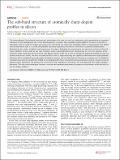The sub-band structure of atomically sharp dopant profiles in silicon
Abstract
The downscaling of silicon-based structures and proto-devices has now reached the single-atom scale, representing an important milestone for the development of a silicon-based quantum computer. One especially notable platform for atomic-scale device fabrication is the so-called Si:P δ-layer, consisting of an ultra-dense and sharp layer of dopants within a semiconductor host. Whilst several alternatives exist, it is on the Si:P platform that many quantum proto-devices have been successfully demonstrated. Motivated by this, both calculations and experiments have been dedicated to understanding the electronic structure of the Si:P δ-layer platform. In this work, we use high-resolution angle-resolved photoemission spectroscopy to reveal the structure of the electronic states which exist because of the high dopant density of the Si:P δ-layer. In contrast to published theoretical work, we resolve three distinct bands, the most occupied of which shows a large anisotropy and significant deviation from simple parabolic behaviour. We investigate the possible origins of this fine structure, and conclude that it is primarily a consequence of the dielectric constant being large (ca. double that of bulk Si). Incorporating this factor into tight-binding calculations leads to a major revision of band structure; specifically, the existence of a third band, the separation of the bands, and the departure from purely parabolic behaviour. This new understanding of the band structure has important implications for quantum proto-devices which are built on the Si:P δ-layer platform.
Citation
Mazzola , F , Chen , C-Y , Rahman , R , Zhu , X-G , Polley , C M , Balasubramanian , T , King , P , Hofmann , P , Miwa , J A & Wells , J W 2020 , ' The sub-band structure of atomically sharp dopant profiles in silicon ' , npj Quantum Materials , vol. 5 , 34 . https://doi.org/10.1038/s41535-020-0237-1
Publication
npj Quantum Materials
Status
Peer reviewed
ISSN
2397-4648Type
Journal article
Description
This work was partly supported by the Research Council of Norway through its Centres of Excellence funding scheme, Project Number 262633, ‘QuSpin’, and through the Fripro program, Project Numbers 250985 ‘FunTopoMat’, 262339 ‘NEAT’, and by the Villum Fonden through the Centre of Excellence for Dirac Materials (Grant No. 11744). J.A.M. acknowledges funding support from the Danish Council for Independent Research, Natural Sciences under the Sapere Aude program (Grant No. DFF-6108-00409) and the Aarhus University Research Foundation. P.D.C.K. acknowledges financial support from The Royal Society.Collections
Items in the St Andrews Research Repository are protected by copyright, with all rights reserved, unless otherwise indicated.

